The Twin Neck Bottles Market is estimated to be valued at USD 3.2 billion in 2025 and is projected to reach USD 6.0 billion by 2035, registering a compound annual growth rate (CAGR) of 6.5% over the forecast period.
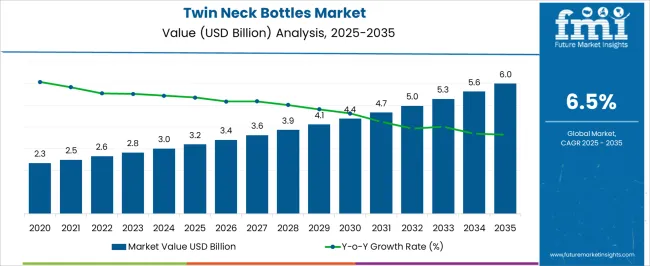
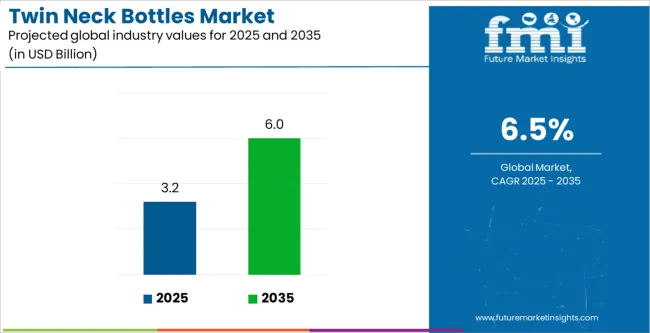
| Metric | Value |
|---|---|
| Twin Neck Bottles Market Estimated Value in (2025 E) | USD 3.2 billion |
| Twin Neck Bottles Market Forecast Value in (2035 F) | USD 6.0 billion |
| Forecast CAGR (2025 to 2035) | 6.5% |
The Twin Neck Bottles market is witnessing steady expansion, driven by rising demand for innovative and convenient packaging solutions across the food, beverage, and personal care industries. Increasing consumer preference for lightweight, recyclable, and durable packaging materials has encouraged manufacturers to adopt twin neck designs that improve handling, storage, and pouring efficiency.
The current market is largely shaped by evolving distribution networks, modern retail formats, and heightened consumer awareness regarding packaging sustainability. Investments in automated filling and packaging lines, combined with advances in material processing, are facilitating the production of bottles with consistent quality and improved performance.
Additionally, regulatory frameworks promoting recyclable and eco-friendly materials have reinforced the adoption of polyethylene terephthalate (PET) as a preferred material The outlook for the market remains positive, with opportunities emerging in regions with growing packaged food demand, expanding e-commerce platforms, and increasing need for compact, user-friendly packaging that supports convenience and product differentiation.
The twin neck bottles market is segmented by material type, bottle capacity, end use, and geographic regions. By material type, twin neck bottles market is divided into Polyethylene Terephthalate (PET), High Density Polyethylene (HDPE), Polypropylene (PP), and Others. In terms of bottle capacity, twin neck bottles market is classified into 100 ml to 500 ml, Up to 100 ml, 500 ml to 1000 ml, and More than 1000 ml. Based on end use, twin neck bottles market is segmented into Food, Pharmaceutical, Chemical, Pesticides And Insecticides, Industrial, Automotive, and Others. Regionally, the twin neck bottles industry is classified into North America, Latin America, Western Europe, Eastern Europe, Balkan & Baltic Countries, Russia & Belarus, Central Asia, East Asia, South Asia & Pacific, and the Middle East & Africa.
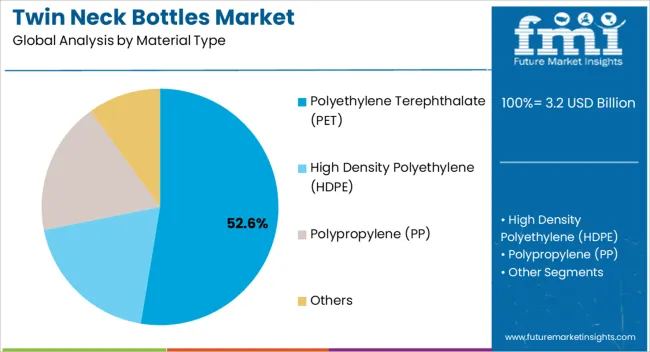
The Polyethylene Terephthalate (PET) material type is projected to hold 52.60% of the Twin Neck Bottles market revenue share in 2025, making it the leading material segment. This dominance is being attributed to its lightweight, durable, and recyclable characteristics, which offer advantages for both manufacturers and end users. PET bottles provide high resistance to impact, maintaining structural integrity during transportation and handling.
The growth of this segment has been reinforced by regulatory support for recyclable packaging and increasing consumer preference for eco-friendly solutions. Additionally, PET allows for high clarity, aesthetic appeal, and compatibility with various filling and sealing technologies, which enhances brand visibility and product shelf appeal.
Its thermal stability and chemical resistance enable safe storage of a variety of liquids, including food, beverages, and personal care products As production efficiency improves and recycling infrastructure expands, PET twin neck bottles are expected to maintain their leadership position in the market.
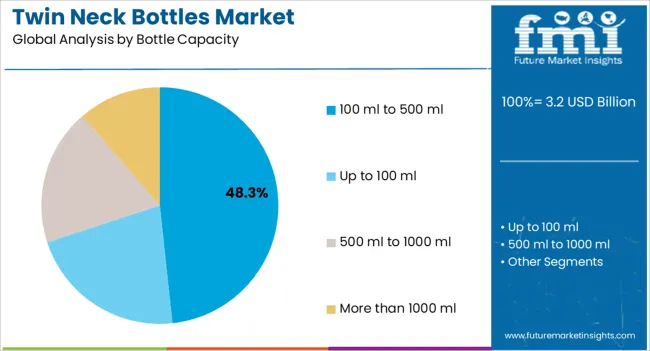
The 100 ml to 500 ml bottle capacity segment is expected to capture 48.30% of the total Twin Neck Bottles market revenue in 2025, emerging as the most prominent capacity range. This leading position is being driven by the widespread application of medium-capacity bottles in food, beverage, and personal care packaging, where portability, convenience, and controlled dispensing are key considerations.
Medium-capacity bottles allow for efficient storage, handling, and shipping while meeting consumer expectations for single-use and multi-use products. The growth of this segment has been facilitated by manufacturing processes that optimize material usage without compromising bottle strength or performance.
Additionally, this capacity range is compatible with automated filling and labeling systems, which enhances operational efficiency for manufacturers The segment’s flexibility to accommodate diverse product types and maintain ease of use is expected to sustain demand, particularly in retail and e-commerce channels where consumer convenience and compact packaging are highly valued.
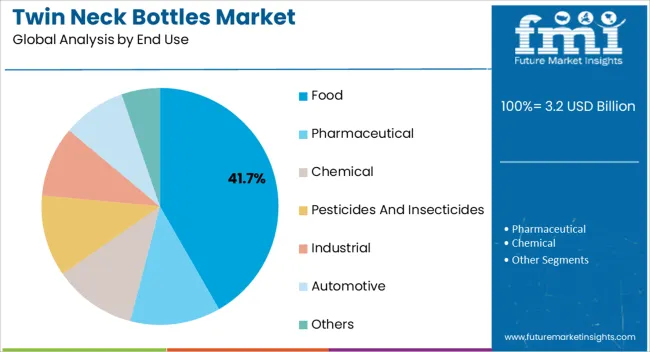
The Food end-use segment is projected to hold 41.70% of the Twin Neck Bottles market revenue in 2025, establishing it as the leading end-use category. This prominence is being attributed to the increasing demand for packaged food products that require safe, hygienic, and convenient storage solutions. Twin neck bottles provide controlled dispensing and minimize product wastage, which is particularly valued in sauces, condiments, and liquid food products.
Growth in the food segment has been supported by urbanization, rising disposable incomes, and changing consumer lifestyles that favor ready-to-use and packaged options. The segment has also benefited from innovations in bottle design that improve shelf stability, leak-proof performance, and ease of handling.
Manufacturers are increasingly adopting twin neck bottles to enhance brand differentiation while complying with food safety regulations As packaged food consumption continues to rise globally, this segment is expected to maintain its leadership, driven by the combination of convenience, functionality, and growing consumer preference for safe and sustainable packaging solutions.
Twin neck bottle is an effective solution for the packaging of variety of liquid products in the pharmaceuticals, chemicals, automotive, and other industries. The bottle is also known as double neck or bettix twin neck bottle. It is very useful packaging product to pour any liquid product in a predefined amount. Its unique design and the dispensing system make it ideal storage and pouring solution for drugs in the pharmaceutical industry.
The bottles could be made up of different thermoplastic materials such as polypropylene, polyethylene, PET and others. The design of bottles is made such that it is helpful in eliminating traditional two-hand pouring or filling of any liquid. This type of bottles possesses high impact resistance, chemical resistance, and rigidity. It is very useful for the variety of tasks such as handling solutions in lab, liquids in kitchen, industrial liquid storage, etc. Its design is very simple and easy to manufacture through the bottle blowing process.
Some of the global companies offer twin neck bottles to their customers in different end-use industries. Twin neck bottles are available in variety of shapes and sizes from 4 OZ to more than 2 liters. Also, some of the common neck finishes of the twin neck bottles are 20-400, 24-410, 28-410, 28-400, and 38-400.
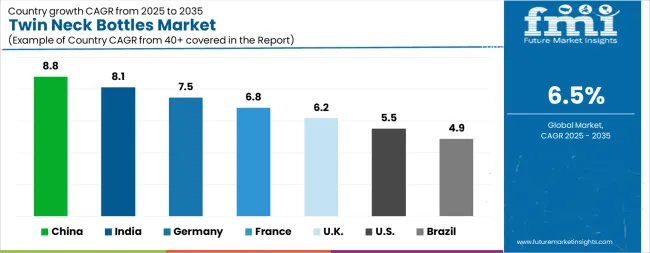
| Country | CAGR |
|---|---|
| China | 8.8% |
| India | 8.1% |
| Germany | 7.5% |
| France | 6.8% |
| UK | 6.2% |
| USA | 5.5% |
| Brazil | 4.9% |
The Twin Neck Bottles Market is expected to register a CAGR of 6.5% during the forecast period, exhibiting varied country level momentum. China leads with the highest CAGR of 8.8%, followed by India at 8.1%. Developed markets such as Germany, France, and the UK continue to expand steadily, while the USA is likely to grow at consistent rates. Brazil posts the lowest CAGR at 4.9%, yet still underscores a broadly positive trajectory for the global Twin Neck Bottles Market. In 2024, Germany held a dominant revenue in the Western Europe market and is expected to grow with a CAGR of 7.5%. The USA Twin Neck Bottles Market is estimated to be valued at USD 1.1 billion in 2025 and is anticipated to reach a valuation of USD 1.9 billion by 2035. Sales are projected to rise at a CAGR of 5.5% over the forecast period between 2025 and 2035. While Japan and South Korea markets are estimated to be valued at USD 166.5 million and USD 80.0 million respectively in 2025.
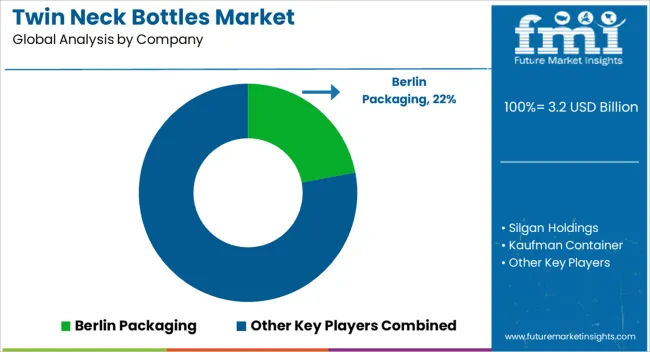
| Item | Value |
|---|---|
| Quantitative Units | USD 3.2 Billion |
| Material Type | Polyethylene Terephthalate (PET), High Density Polyethylene (HDPE), Polypropylene (PP), and Others |
| Bottle Capacity | 100 ml to 500 ml, Up to 100 ml, 500 ml to 1000 ml, and More than 1000 ml |
| End Use | Food, Pharmaceutical, Chemical, Pesticides And Insecticides, Industrial, Automotive, and Others |
| Regions Covered | North America, Europe, Asia-Pacific, Latin America, Middle East & Africa |
| Country Covered | United States, Canada, Germany, France, United Kingdom, China, Japan, India, Brazil, South Africa |
| Key Companies Profiled | Berlin Packaging, Silgan Holdings, Kaufman Container, Richmond Containers, IGH Holdings, Charles Tennant, Hangzhou Glory Industry, Richards Packaging, O.Berk, Silverlock Packaging, and Hebei Shengxiang Package Materials |
The global twin neck bottles market is estimated to be valued at USD 3.2 billion in 2025.
The market size for the twin neck bottles market is projected to reach USD 6.0 billion by 2035.
The twin neck bottles market is expected to grow at a 6.5% CAGR between 2025 and 2035.
The key product types in twin neck bottles market are polyethylene terephthalate (pet), high density polyethylene (hdpe), polypropylene (pp) and others.
In terms of bottle capacity, 100 ml to 500 ml segment to command 48.3% share in the twin neck bottles market in 2025.
Explore Similar Insights

Thank you!
You will receive an email from our Business Development Manager. Please be sure to check your SPAM/JUNK folder too.
Chat With
MaRIA